kuih (plural: kuih mueh): local, traditional-style cakes and morsels that use native ingredients and are generally sweet, occasionally savoury, and sometimes both. typical main ingredients are some form of glutinous rice, coconut, and gula melaka (palm sugar). you can find them anywhere there is food; in kl, there is food everywhere.
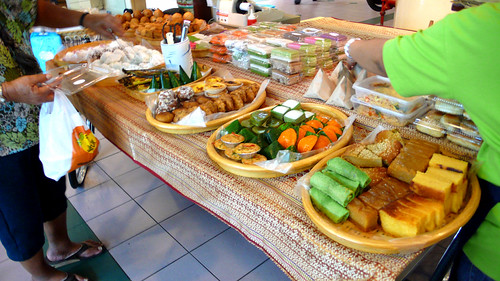

i had more than my share of different kuihs, not all of them photographed as they were more important as food than as models. here are some of the ones that didn't get gobbled down straightaway.
after our dinner, miss boo took me to a market area of kampung baru, where she bought me putu bambu, very similar to the filipino puto bumbong, which are also steamed in pieces of bamboo. small lengths of bamboo are cut down, and a dryish glutinous rice flour mixture is packed into them. they are placed upright onto a special steamer. once they are done, they are pushed out of the bamboo length, topped with fresh coconut and gula melaka, and the process is repeated endlessly into the night. these were lighter in flavour and texture than the filipino version (mainly because the pinoy version adds ube, or purple mountain yam), but just as delicious.
pulut inti is a cute little pyramid of steamed glutinous rice, topped with a mound of coconut and gula melaka. the thing that sets it apart from the rest is the unique shape, and the fairly equal ratio of coconut to sugar to rice.
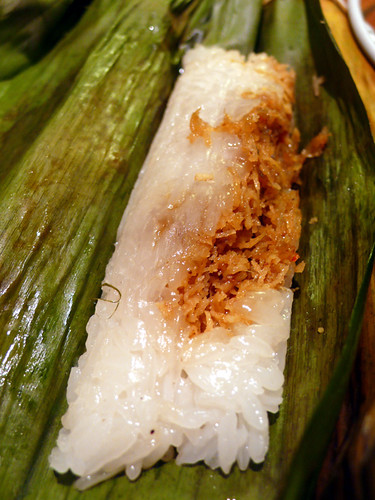
after our dinner, miss boo took me to a market area of kampung baru, where she bought me putu bambu, very similar to the filipino puto bumbong, which are also steamed in pieces of bamboo. small lengths of bamboo are cut down, and a dryish glutinous rice flour mixture is packed into them. they are placed upright onto a special steamer. once they are done, they are pushed out of the bamboo length, topped with fresh coconut and gula melaka, and the process is repeated endlessly into the night. these were lighter in flavour and texture than the filipino version (mainly because the pinoy version adds ube, or purple mountain yam), but just as delicious.
pulut inti is a cute little pyramid of steamed glutinous rice, topped with a mound of coconut and gula melaka. the thing that sets it apart from the rest is the unique shape, and the fairly equal ratio of coconut to sugar to rice.

pulut udang is similar to the pinoy suman, in that it is glutinous rice steamed in banana leaf, but it contains a sweet-savoury filling of chopped dried prawn or anchovy, mixed with a bit of sugar. a little odd, but tasty combination.
my favourite of all of them, however, would have to be the kuih ketayap--a small pandan flavoured crêpe wrapped around a gula melaka and coconut filling. there's something about the moist, spongy pancake in contrast with the nutty, sweet interior that i really enjoyed. if anyone has a recipe for this, send it my way!
i have more photos...somewhere....will have to add them on as i come across them....
my favourite of all of them, however, would have to be the kuih ketayap--a small pandan flavoured crêpe wrapped around a gula melaka and coconut filling. there's something about the moist, spongy pancake in contrast with the nutty, sweet interior that i really enjoyed. if anyone has a recipe for this, send it my way!
i have more photos...somewhere....will have to add them on as i come across them....


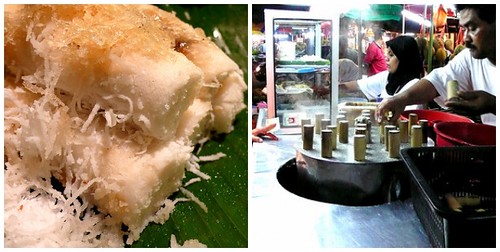
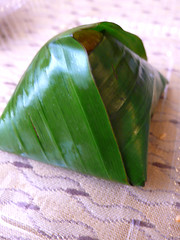

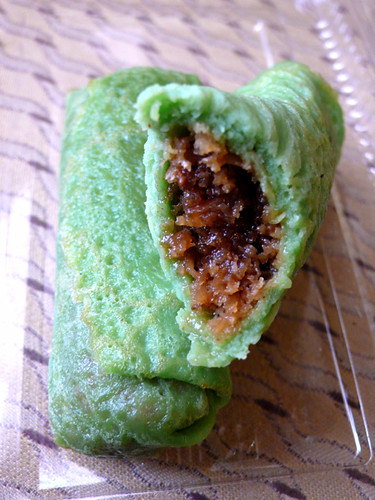



11 comments:
5/19/2008 06:25:00 PM
Wow, those look great! If I hadn't just eaten some bibingka I'd be licking my monitor. :-)
5/19/2008 07:20:00 PM
bibingka?! wherewhere?
5/19/2008 07:47:00 PM
S,
My favorite is the pulut inti. In Singapore, the rice is normally colored a bright blue. They use the bunga telang (butterfly pea flower) to dye the rice this color.
Another type of kueh that uses the bunga telang is the pulut tai tai. It is normally served with kaya.
mmmmmmm!
5/19/2008 07:51:00 PM
You are teasing me.. Santos..!! they are all my favourites.. :)
5/19/2008 09:07:00 PM
hi reid, blue you say? i need to see/try that! and the pulut tai tai--anything with kaya is fine with me.
hallo mamabok, looking back on the photos above really makes my mouth water too. so many that i didn't try! and i miss the ones i did :)
5/19/2008 11:51:00 PM
Gosh, everything is beautiful... that last item sounds especially delicious. I got to try a pandan-flavored something several years ago (forget what it's called - a sort of coconut jam) - anyway, I loved it! I remember Renee saying that to Singaporeans, pandan was a flavor so familar, it was like vanilla. To me of course, it's exotic - but in a comfy, friendly way. Mmmmmm!
5/21/2008 09:13:00 AM
Caachi Films (http://www.caachi.com) is inviting you to download for free "Dat Kho: Land of Sorrows", "Five", "My life ... disoriented" and "Shift". If you like the films, please let your website visitors know about them and join our affiliate program (see the link below).
To download your films, contact us at films@caachi.com, and we'll send you film tickets and instructions to download the films. By the way, here's the original message we wanted to send to you (but we didn't have your email address):
http://stream.caachi.com/~caachi/mailings/affiliate/2008_05_10_asian.html
Best,
Tom and the Caachi crew
5/21/2008 10:50:00 AM
What beautiful goodies. Mochi rice and coconut go so well together. I would love to sample everything.
5/23/2008 03:01:00 AM
Hey Santos - I gotta make sure to keep the Missus away from this post. There's nothing here close to that......
5/25/2008 02:21:00 PM
I love kuih ketayap (also known as kuih dadar) too!
6/03/2008 12:04:00 PM
Actually, puto bumbong is purple not because of ube, but because they add black rice or pirurutong to the coconut milk, and it becomes purple :)
Post a Comment